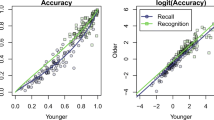Abstract
A computer-assisted version of the delayed matching-to-sample (DMTS) task has been of enormous utility in our non-human primate model for assessment of memory-enhancing agents. To avoid ceiling effects as might be encountered by using fixed delay intervals in monkeys exhibiting varying performance efficiencies, delay intervals are adjusted to provide similar baseline levels of delay-dependent performance. Macaques well trained in the task exhibited a marked age-dependent sensitivity to the effects of the amnestic drug scopolamine. Aged animals also were more affected than their younger counterparts by the presentation of a distractor shortly after receiving the stimulus component of the DMTS task. One limitation of the DMTS task is that under baseline conditions certain aged subjects may perform the task as well or better than some younger animals. To help avoid this situation, we developed a titrating version of the DMTS which was administered similarly to the standard DMTS task. Animals begin the first trial with a 0 s delay interval. Delay intervals after a correct response are incremented by 1 s. Delay intervals after an incorrect match are decreased by 1 s. Rhesus and pigtail macaques who ranged in age from 5–27 years and who were maintained on the standard DMTS for at least one year performed 3–4 consecutive 96 trial sessions. The maximum delay intervals attained by the study group, exhibited a significant correlation with age (p<0.02). Decrements in task accuracy, and in te number of trials completed/session showed a trend with age (p<0.08). If the titrating version of the DMTS is sensitive to mnemonic drugs, the task may prove useful for drug comparisons with aging.
Similar content being viewed by others
References
Bartus R. T. (2000) On neurodegenerative diseases, models, and treatment strategies: Lessons learned and lessons forgotten a generation following the cholinergic hypothesis. Exp. Neurol. 163, 495–529.
Buccafusco J. J. and Jackson W. J. (1991) Beneficial effects of nicotine administered prior to a delayed matching-to-sample task in young and aged monkeys. Neurobiol. Aging 12, 233–238.
Buccafusco J. J., Jackson W. J., Gattu M., and Terry A. V. Jr. (1995) Isoarecolone-induced memory enhancement in monkeys: role of nicotinic receptors. Neuro-Report 6, 1223–1227.
Buccafusco J. J., Jackson W. J., Jonnala R. R., and Terry A. V. Jr. (1999) Differential improvement in memory-related task performance to nicotine by aged male and female rhesus monkeys. Behav. Pharmacol. 10, 681–690.
Buccafusco J. J. and Terry A. V. Jr. (2000) Multiple CNS targets for eliciting beneficial effects on memory and cognition. J. Pharmacol. Exp. Therapeut. 295, 438–446.
Davis H. P., Cohen A., Gandy M., Colombo P., VanDusseldorp G., Simolke N., and Romano J. (1990) Lexical priming deficits as a function of age. Behav. Neurosci. 104, 288–297.
Hoyer W. J., Rebok G. W., and Marx Sved S. (1979) Effects of varying irrelevant information on adult age differences in problem solving. J. Gerontol. 34, 553–560.
Irle E., Kessler J., and Markowitsch H. J. (1987) Primate learning tasks reveal strong impairments in patients with presenile or senile dementia of the Alzheimer type. Brain Cogn. 6, 429–449.
Jackson W. J., Reite M. L., and Buxton D. F. (1969) The chimpanzee central nervous system: a comparative review, in Primates in Medicine, vol. 4.Chimpanzee: Central Nervous System and Behavior; A Review (Reynolds H. H., ed.), Karger, New York, pp. 1–51.
Jackson W. J., Stone J. D., Terry A. V., Jr. and Buccafusco J. J. (2000) Differential improvement in memory-related task performance to Aricept by aged male and female rhesus monkeys. Society Neurosci. Abstr. 26, 2015.
Prendergast M. A., Jackson W. J., Terry A. V. Jr., Kille N. J., Arneric S. P., and Buccafusco J. J. (1998a) Age-related: differences in distractibility and response to methylphenidate in monkeys. Cerebr. Cortex 8, 164–172.
Prendergast M. A., Jackson W. J., Terry A. V. Jr., Decker M. W., Arneric S. A., Buccafusco J. J. (1998b) Central nicotinic receptor agonists ABT-418, ABT-089, and (-)-Nicotine reduce distractibility in young-adult monkeys. Psychopharmacology 136, 50–58.
Rumbaugh D. M. (1973) Learning skills of anthropoids in: Primate Behavior: Developments in Field and Laboratory Research (Rosenblum, L. A., ed.), Academic Press, New York, NY, pp. 1–70.
Seabrook G. R. and Rosahl T. W. (1999) Transgenic animals relevant to Alzheimer’s disease. Neuropharmacology 38, 1–17.
Smith D., Roberts J., Gage F., and Tuszynski M. (1999) Age-associated neuronal atrophy occurs in the primate brain and is reversible by growth factor gene therapy. Proc. Natl. Acad. Sci. USA 96, 10893–10898.
Squire L. R., Zola-Morgan S., and Chen K. S. (1988) Human amnesia and animal models of amnesia: Performance of amnesic patients on tests designed for the monkey. Behav. Neurosci. 102, 210–221.
Sturchler-Pierrat C. and Sommer B. (1999) Transgenic animals in Alzheimer’s disease research. Rev. Neurosci. 10, 15–24.
Summers J. B., Prendergast M. A., Hill W. D., and Buccaufsco J. J. (1997) Localization of ubiquitin in the plaques of five aged primates by dual-label fluorescent immunhistochemistry. Alzheimer’s Res. 3, 11–21.
Summers J. B., Hill W. D., Prendergast M. A., and Buccafusco J. J. (1998) Co-localization of apolipoprotein E and beta-amyloid in plaques and cerebral blood vessels of aged non-human primates. Alzheimer’s Rep. 1, 119–128.
Voytko M. L. (1998) Nonhuman primates as models for aging and Alzheimer’s disease. Lab. Animal Sci. 48, 611–617.
Author information
Authors and Affiliations
Corresponding author
Rights and permissions
About this article
Cite this article
Buccafusco, J.J., Terry, A.V. & Murdoch, P.B. A computer-assisted cognitive test battery for aged monkeys. J Mol Neurosci 19, 179–185 (2002). https://doi.org/10.1007/s12031-002-0030-6
Received:
Accepted:
Issue Date:
DOI: https://doi.org/10.1007/s12031-002-0030-6




